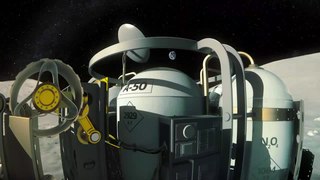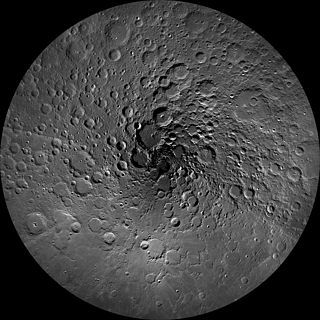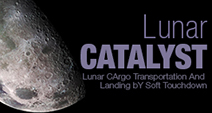Related Research Articles

The Google Lunar X Prize (GLXP) was a 2007–2018 inducement prize space competition organized by the X Prize Foundation, and sponsored by Google. The challenge called for privately funded teams to be the first to land a lunar rover on the Moon, travel 500 meters, and transmit back to Earth high-definition video and images.

Astrobotic Technology, Inc., commonly referred to as Astrobotic, is an American private company that is developing space robotics technology for lunar and planetary missions. It was founded in 2007 by Carnegie Mellon professor Red Whittaker and his associates with the goal of winning the Google Lunar X Prize. The company is based in Pittsburgh, Pennsylvania. Their first launch occurred on January 8, 2024, as part of NASA's Commercial Lunar Payload Services (CLPS) program. The launch carried the company's Peregrine lunar lander on board the first flight of the Vulcan Centaur rocket from Florida's Space Force Station LC-41. The mission was unable to reach the Moon for a soft or hard landing. On June 11, 2020, Astrobotic received a second contract for the CLPS program. NASA would pay Astrobotic US$199.5 million to take the VIPER rover to the Moon, targeting a landing in November 2024. In July 2024, NASA announced that VIPER had been cancelled.

The lunar north pole is the point in the Northern Hemisphere of the Moon where the lunar axis of rotation meets its surface.

Hakuto (ハクト) or formerly White Label Space (ホワイトレーベルスペース) was a team formed in early 2008 by a group of experienced space professionals inspired by the challenge of the Google Lunar X PRIZE to develop a robotic Moon exploration mission.

A lunar rover or Moon rover is a space exploration vehicle designed to move across the surface of the Moon. The Apollo program's Lunar Roving Vehicle was driven on the Moon by members of three American crews, Apollo 15, 16, and 17. Other rovers have been partially or fully autonomous robots, such as the Soviet Union's Lunokhods, Chinese Yutus, Indian Pragyan, and Japan's LEVs. Five countries have had operating rovers on the Moon: the Soviet Union, the United States, China, India, and Japan.

SpaceIL is an Israeli organization, established in 2011, that competed in the Google Lunar X Prize (GLXP) contest to land a spacecraft on the Moon.

The Lunar CATALYST initiative is an attempt by NASA to encourage the development of robotic lunar landers that can be integrated with United States commercial launch capabilities to deliver payloads to the lunar surface.

Resource Prospector is a cancelled mission concept by NASA of a rover that would have performed a survey expedition on a polar region of the Moon. The rover was to attempt to detect and map the location of volatiles such as hydrogen, oxygen and lunar water which could foster more affordable and sustainable human exploration to the Moon, Mars, and other Solar System bodies.

Commercial Lunar Payload Services (CLPS) is a NASA program to hire companies to send small robotic landers and rovers to the Moon. Most landing sites are near the lunar south pole where they will scout for lunar resources, test in situ resource utilization (ISRU) concepts, and perform lunar science to support the Artemis lunar program. CLPS is intended to buy end-to-end payload services between Earth and the lunar surface using fixed-price contracts. The program achieved the first landing on the Moon by a commercial company in history with the IM-1 mission in 2024. The program was extended to add support for large payloads starting after 2025.
ispace Inc. is a publicly traded Japanese company developing robotic spacecraft and other technology to compete for both transportation and exploration mission contracts from space agencies and other private industries. ispace's mission is to enable its clients to discover, map, and use natural lunar resources.

Orbit Beyond, Inc., usually stylized as ORBITBeyond, is an aerospace company that builds technologies for lunar exploration. Its products include configurable delivery lunar landers with a payload capacity of up to 300 kg (660 lb), and rovers.

CubeRover is a class of planetary rover with a standardized modular format meant to accelerate the pace of space exploration. The idea is equivalent to that of the successful CubeSat format, with standardized off-the-shelf components and architecture to assemble small units that will be all compatible, modular, and inexpensive.

The Artemis program is a Moon exploration program led by the United States' National Aeronautics and Space Administration (NASA), formally established in 2017 via Space Policy Directive 1. It is intended to reestablish a human presence on the Moon for the first time since the Apollo 17 mission in 1972. The program's stated long-term goal is to establish a permanent base on the Moon to facilitate human missions to Mars.

Peregrine Lunar Lander flight 01, commonly referred to as Peregrine Mission One, was an unsuccessful American lunar lander mission. The lander, dubbed Peregrine, was built by Astrobotic Technology and carried payloads for the NASA Commercial Lunar Payload Services (CLPS) program. Peregrine Mission One launched on 8 January 2024, at 2:18 am EST, on the maiden flight of the Vulcan Centaur (Vulcan) rocket. The goal was to land the first U.S.-built lunar lander on the Moon since the crewed Apollo Lunar Module on Apollo 17 in 1972.

VIPER is a lunar rover which was developed at the NASA Ames Research Center. Before the project was cancelled in 2024 the rover would have been tasked with prospecting for lunar resources in permanently shadowed areas of lunar south pole region, especially by mapping the distribution and concentration of water ice. The mission built on a previous NASA rover concept, the Resource Prospector, which had been cancelled in 2018.

IM-2 is an upcoming lunar mission that will be carried out in January 2025 by Intuitive Machines for NASA's CLPS program, using a Nova-C lunar lander. The company named this lander Athena. The mission aims to uncover the presence and amount of lunar water ice using PRIME-1, which consists of a drill and mass spectrometer. The lander will carry a Micro Nova Hopper, a drone that will utilize its neutron spectrometer in the PSR of the nearby Marston crater. If successful, this would provide the first measurement of hydrogen on the surface in the PSR, a key indicator of water.
Memory of Mankind on the Moon was a time capsule that was launched onboard Astrobotic Technology's Peregrine lander. It was made in collaboration with Hungarian company Puli Space Technologies and Memory of Mankind.
References
- ↑ Lunar XPrize - Team AngelicvM. Archived 2018-08-05 at the Wayback Machine Accessed: 4 August 2018.
- 1 2 3 Team AngelicvM Will Fly with Astrobotic on First Lunar Mission Archived 2018-08-04 at the Wayback Machine . Astrobotic Technology Press Release. 27 October 2015.
- ↑ "Overview". Google Lunar XPRIZE. Archived from the original on 3 March 2016. Retrieved 18 February 2016.
- ↑ Updates on GLXP teams from Israel, India and Japan. Phillip Keane, Space Tech. July 18, 2018.
- 1 2 3 La silenciosa carrera espacial chilena. Valentina Echeverría, Km Zero. Accessed : 4 August 2018. (in Spanish)
- 1 2 Chile's first lunar rover nears completion Archived 2018-08-05 at the Wayback Machine . Chile's Education, Science, and Technology NEWS. 18 December 2012.
- ↑ El Team AngelicvM presentó su rover AngelicvM 1. Felipe Campos Cosmo Noticias. 27 June 2013. (in Spanish).
- ↑ Astrobotic and United Launch Alliance Announce Mission to the Moon. United Launch Alliance - Press Release. 26 July 2017.
- ↑ Former Google Lunar X Prize Teams Focused on Commercial and Government Opportunities. Jeff Foust, Space. 27 May 2018.
- ↑ Coli, Michael (19 March 2018). "Astrobiotic Ready to Become Delivery Service to the Moon". Spaceflight Insider. Retrieved 27 July 2018.
- ↑ Ray, Justin (26 July 2017). "Commercial lunar mission signs up with Atlas 5 for launch". Spaceflight Now. Retrieved 3 August 2017.
- 1 2 Astrobiotic Ready to Become Delivery Service to the Moon. Michael Coli, Spaceflight Insider. 19 March 2018.
- ↑ Angelicvm: Chile hacia la Luna. Felipe Campos, Cosmo Noticias (in Spanish). 29 December 2012.
- 1 2 3 4 Dandelion rover Archived 2018-08-05 at the Wayback Machine . Robotic & Environmental Algorithms Laboratory (REAL). Accessed: 4 August 2018.
- ↑ "Testing Unity in the Mojave Desert". YouTube . 27 October 2015.
- ↑ Astrobotic Adds Another Google Lunar X Prize Team to Its Lander. Jeff Foust, Space News. 27 October 2015.